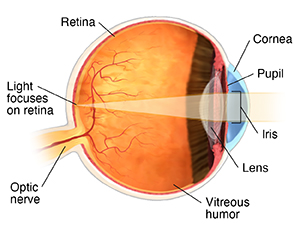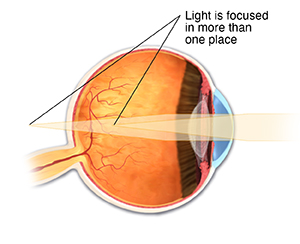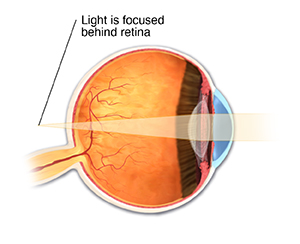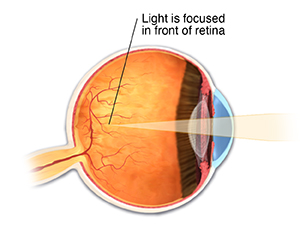Refractive Errors in Children
What is normal vision?

To understand how certain problems can affect your child's vision, it’s important
to know how normal vision happens. For children with normal vision, the following
things occur in this order:
-
Light enters the eye through the cornea. This is the clear, dome-shaped surface that
covers the front of the eye.
-
From the cornea, the light passes through the pupil. The amount of light passing through
is controlled by the iris. This is the colored part of your eye.
-
From there, the light then hits the lens. This is the clear structure inside the eye
that focuses light rays onto the retina.
-
Next, the light passes through the vitreous humor. This is the clear, jelly-like substance
that fills the center of the eye. It helps to keep the eye round in shape.
-
Finally, the light reaches the retina. This is the light-sensitive nerve layer that
lines the back of the eye.
-
The optic nerve carries signals of light, dark, and colors to the brain’s visual cortex.
This part of the brain turns the signals into images (our vision).
What are refractive errors?
The following are the most common refractive errors, all of which affect vision. Your
child may need corrective lenses for correction or improvement if they have any of
these:
Astigmatism
This condition makes objects look blurry. It happens because an abnormal curvature
of the cornea can cause 2 focal points to fall in 2 different locations. Astigmatism
may cause eye strain and may be combined with nearsightedness or farsightedness. The
condition can start in childhood or in adulthood. Some symptoms include headache,
eye strain, or severe tiredness (fatigue). Eye rubbing, lack of interest in school,
and trouble reading are often seen in children with astigmatism. Depending on the
severity, eyeglasses or contact lenses may be needed.

Farsightedness (hyperopia)
Farsightedness makes close objects look out of focus. With this refractive error,
an image of a distant object becomes focused behind the retina. This happens either
because the eye is too short, or because the eye’s refractive power is too weak. Farsightedness
may cause headaches, eye strain, or severe tiredness (fatigue). Squinting, eye rubbing,
lack of interest in school, and trouble reading are often seen in children with this
condition. Eyeglasses or contact lenses may help to correct or improve farsightedness
by adjusting the focusing power to the retina.

Nearsightedness (myopia)
Nearsightedness makes distant objects look out of focus. It is the most common refractive
error needing correction that is seen in children. It may cause headaches or eye strain.
With this condition, an image of a distant object becomes focused in front of the
retina. This happens either because the eye is too long, or because the eye’s refractive
power is too strong. Eyeglasses or contact lenses may help to correct or improve nearsightedness
by adjusting the focusing power to the retina.

What causes refractive errors?
Refractive errors have been found to cluster in families. A variety of inheritance
patterns have been observed. These include dominant (1 gene passed from a parent with
a refractive error to a child), recessive (caused by 2 genes, 1 inherited from each
parent who may or may not have a refractive error), and multifactorial (combination
of genes and environment). Refractive errors are present in a number of genetic disorders,
such as Marfan syndrome and Down syndrome.